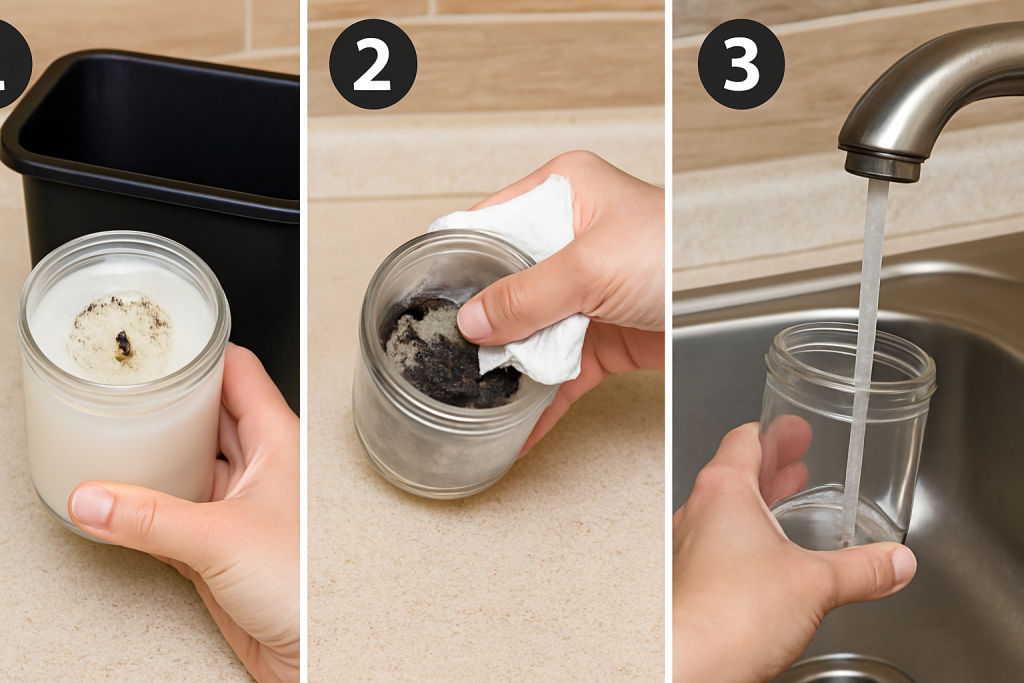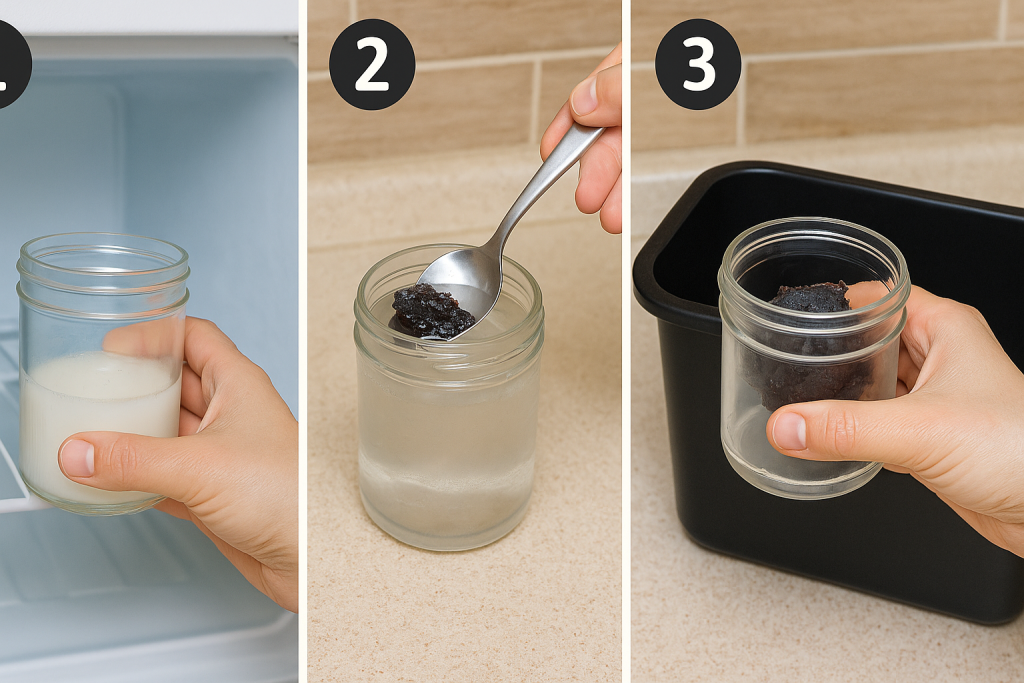No products in the cart.
How to Dispose of Candles: A Safe & Eco-Friendly Guide

Used candles build up quickly. Some are half burned, others are nearly empty with hardened wax at the bottom. Most end up in the trash without a second look. But that simple act can lead to bigger issues.
Paraffin wax is petroleum-based and not biodegradable. Hot wax can clog plumbing if poured down the drain.
Scented candles often contain additives that do not belong in landfills. And glass jars left uncleared just add to the pile.
If you’re wondering how to dispose of candles the right way, this guide breaks it down clearly. From wax to wicks to containers, every part can be handled better.
This is not just about cleanup. It’s about reducing waste and avoiding damage, both in your home and outside of it.
Let’s look at why proper disposal matters.
Why Proper Candle Disposal Matters
Most store-bought candles are made with paraffin, a wax derived from petroleum. Once tossed, it doesn’t break down.
Instead, it sits in landfills, leaching into soil and contributing to long-term waste problems. Scented varieties often contain dyes, binders, and synthetic fragrance oils that aren’t safe for compost or landfills.
These can release toxic compounds when burned and linger in the environment long after the candle is gone.
Throwing out candles before they’ve fully cooled is a risk. Hot wax can melt trash liners or ignite nearby materials.
Even hardened wax, when dumped down a drain or into a sink, can cool and harden inside pipes, leading to costly plumbing repairs.
A simple oversight can cause real damage at home, especially when dealing with certain wax blends that retain heat longer than expected.
How to Dispose of Leftover Candle Wax

Step 1: Let the Wax Cool Completely
Start by letting the wax sit until it’s room temperature. Rushing the process may cause burns or messy spills.
Once it’s fully hardened, removal is much easier and safer. Never try to scrape or pour wax while it’s still warm.
Step 2: Scrape and Wrap for Trash Disposal
For waxes that cannot be composted, especially paraffin, scrape the wax out and wrap it in foil or a paper towel.
Then place it directly in the trash. This prevents it from melting and spreading inside waste bins or creating sticky messes.
Step 3: Eco-Friendly Alternatives for Natural Wax
If you’re using soy, coconut, or beeswax candles without synthetic additives, small amounts of leftover wax can be composted.
These waxes break down much more easily in soil. Another option is to reuse the wax by turning it into fire starters or wax melts.
Simply remelt and pour into silicone moulds, muffin liners, or egg cartons.
How to Remove Wax from Candle Containers

Step 1: Freezer Method
Place the candle jar in the freezer for a few hours. Once cold, the wax will shrink slightly and can be popped out using a spoon or butter knife.
This method works best for containers with wide openings and minimal leftover wax.
Step 2: Boiling Water or Double Boiler Method
If freezing doesn’t work, try the hot water route. Fill the jar with boiling water, let it sit, and wait for the wax to float to the top.
Once it cools, scoop out the solidified wax and clean the jar. Use caution during this process to avoid burns, and don’t pour the waxy water down the sink.
Step 3: Avoid Pouring Wax Down the Drain
No matter the method, never rinse wax out directly into a drain. Even natural wax can harden and build up inside plumbing.
Always collect the leftover wax and dispose of it properly to avoid long-term pipe issues.
Reusing or Recycling Candle Containers
1. Reuse Glass Jars Creatively
Clean candle jars can be repurposed in dozens of ways. Use them to store spices, cotton swabs, tea bags, paper clips, or even turn them into mini planters.
Their sturdy build and elegant designs make them perfect for small storage across your home or workspace.
2. Check Recycling Eligibility
Not all recycling centers accept candle jars, especially if they’re still coated with wax or contain metal wick tabs.
Always remove any remaining wax and the metal piece at the bottom.
Then check your local recycling guidelines to confirm if glass or metal parts can be accepted curbside or need to be dropped off.
3. Brands That Offer Candle Recycling Programs
Some brands make recycling easier by offering take-back programs. For example, The Body Shop, Lush, and a few small-batch candle makers accept returns for jars or offer refills.
Before tossing, check the label or visit the company’s website; you might be able to give that jar a second life.
Repurposing Leftover Wax and Wicks
1. Make Your Candles from Scraps
If you’ve got enough leftover wax from multiple candles, consider melting them down and creating a new one.
You’ll need a clean jar, a fresh wick, and a safe way to melt the wax, either with a double boiler or a wax melter.
Mix compatible wax types only, and avoid blending synthetic and natural waxes.
2. Create Wax Melts or Fire Starters
Wax scraps can easily be turned into wax melts. Pour melted wax into silicone trays or moulds and let it cool.
For fire starters, mix wax with dryer lint, wood shavings, or shredded paper and pour into egg cartons or cupcake liners.
These are great for campfires, grills, or fireplaces, and far better than letting wax go to waste.
Disposal Tips for Different Candle Types
1. Paraffin Wax Candles
These are petroleum-based and not suited for composting or recycling. Once cooled and hardened, paraffin wax should be wrapped and placed in household trash.
Never attempt to reuse it in compost or garden beds. Its synthetic base can harm soil quality and doesn’t break down over time.
2. Soy and Beeswax Candles
Soy and beeswax are plant-based and biodegradable in small quantities. If the wax is clean and free of fragrance additives or colorants, it can be composted or used in garden beds.
You can also repurpose leftover bits for new candles or melts, especially if you want to avoid waste altogether.
3. Gel, Decorative, and Scented Candles
These often contain mineral oil, synthetic scents, or embedded decorations like glitter or dried flowers. Because of these additives, gel and decorative candles aren’t suitable for composting.
Dispose of the wax in the trash after removing it from containers, and never pour melted gel wax into the sink or toilet.
Candle Disposal Do’s and Don’ts
Dos for Candle Disposal
- Let wax cool fully before handling or tossing.
- Reuse jars for storage, décor, or crafts.
- Remove all wax and metal parts before recycling containers
- Use natural wax scraps for fire starters or small DIY projects.
Don’ts for Candle Disposal
- Do not pour wax hot or cold into sinks or toilets.
- Do not throw away burning or still-warm candles.
- Do not compost paraffin or dyed, glittery waxes
- Do not recycle jars with residue or metal wick clips still attached.
How to Care for Candles to Reduce Waste
1. Burn Candles Evenly
One of the easiest ways to make your candle last longer is by burning it the right way. Always allow the wax pool to reach the edges of the container during the first burn.
This prevents tunnelling, which wastes wax and shortens the candle’s lifespan. Uneven burns also leave leftover wax along the sides, which often ends up tossed.
By giving the candle enough time to melt evenly, you’ll get the full value out of it and avoid half-used jars. A simple adjustment in burn time can cut down on waste and save money over time.
2. Trim the Wick
Keeping the wick short is not just about appearance; it directly impacts how cleanly and safely your candle burns.
Long or mushroomed wicks cause smoke, flickering, and uneven flames that leave soot on your jar and burn through wax faster. Trim your wick to a quarter inch before each use.
This helps the flame stay steady and slow-burning, so you get more hours out of your candle.
A well-maintained wick also reduces the risk of overheating the jar or creating dangerous flame spikes. It’s a quick habit that makes a big difference.
3. Store Candles Properly
Candles stored in poor conditions can lose scent, melt unevenly, or degrade before they’re ever used. To extend shelf life, keep them in a cool, dry spot away from direct sunlight.
Heat and light can soften wax, distort shape, and dull the fragrance, especially for natural wax types like soy or beeswax.
Avoid leaving them near windows, stoves, or inside hot cars. If possible, store them with the lids on to keep dust out and preserve their scent.
Proper storage not only protects your investment but also ensures a safer and more consistent burn when it’s time to light them.
What to Avoid When Disposing of Candles
1. Don’t Mix Wax Types
Mixing different waxes might sound like a good way to reuse scraps, but it leads to more problems than solutions.
Each wax type has a different melting point, burn rate, and composition. Combining paraffin with soy or gel with beeswax results in uneven burning, separation, or failed attempts at new candles.
If you’re repurposing wax, keep types separated and label them. This avoids wasted time and materials, especially if you’re trying to melt and repour.
If you’re unsure what kind of wax you have, it’s best not to combine it with others.
2. Avoid Candles with Embedded Items
Candles with decorative elements like dried flowers, herbs, glitter, or beads may look great but pose serious disposal and reuse challenges.
These additives can’t be composted or safely burned again. Glitter and synthetic items don’t break down naturally and can release harmful particles if reused in homemade melts.
When discarding these candles, remove as much of the embedded material as possible and throw it in the trash.
The remaining wax should be cooled and discarded properly. If you’re crafting or repurposing, stick to plain, clean wax without added décor for best results.
3. Skip the Sink or Toilet
It might feel harmless to rinse a bit of wax down the drain, but it can cause plumbing issues that cost far more than the candle itself.
Wax solidifies as it cools, sticking to pipes and narrowing the space for water flow. Over time, this buildup can clog your sink or trap other debris.
Toilets are no better. Flushing wax may push the problem farther into your plumbing, where it’s harder to fix.
Always allow wax to harden, scrape it out, and place it in the trash or reuse it. Your pipes and your wallet will thank you.
Final Thoughts
Candle disposal isn’t just about getting rid of leftovers. It’s about handling each part, wax, jars, and wicks with care so they don’t end up creating problems.
Paraffin wax belongs in the trash, but natural waxes like soy and beeswax have options. Glass jars can often be reused or recycled with minimal effort.
Even scraps and stubs can be turned into something useful.
Whether you burn candles daily or just on special occasions, knowing how to dispose of used candles makes a difference.
It helps your home stay clean, your plumbing safe, and your footprint smaller.
Don’t toss, repurpose, or recycle your candles the smart way.
Frequently Asked Questions About Candle Disposal
Can I Recycle Candles?
The wax itself cannot be recycled. However, most glass jars and metal lids can be if cleaned properly. Make sure to remove all wax, wick tabs, and residue before placing them in the recycling bin.
Is Candle Wax Biodegradable?
It depends on the type. Soy wax, beeswax, and coconut wax break down over time and can be composted in small amounts. Paraffin and gel wax are synthetic and will not decompose naturally, making them better suited for trash disposal.
What Can I Do with Old or Unwanted Candles?
If you don’t want to burn them anymore, consider repurposing the wax into melts, fire starters, or layered DIY candles. You can also donate unused or lightly used candles to shelters, donation centers, or community organizations that accept household goods.

Nav Preet is the founder and creative soul behind Karigar Candles. Inspired by heritage, nature, and the warmth of handmade artistry, she crafts candles that do more than glow—they evoke emotion. Through this blog, she shares her love for scents, styling, and mindful living, one flame at a time.
Creative Head at Karigar Style






